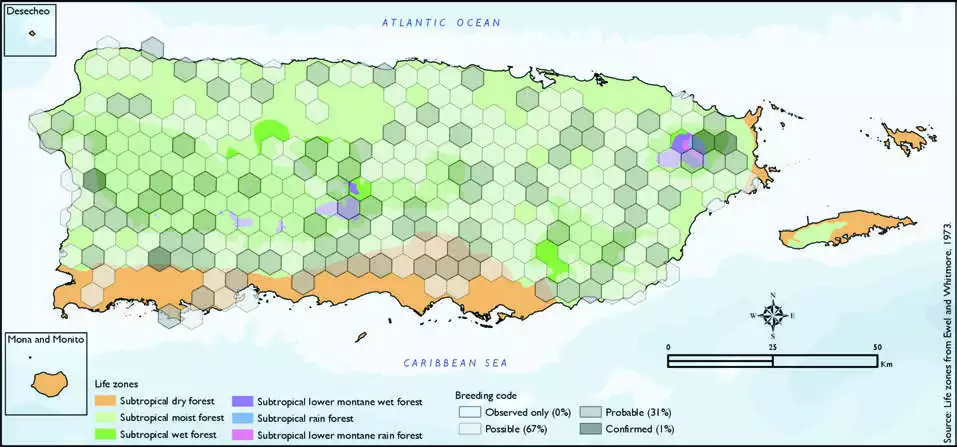Puerto Rican Owl
Description
The Puerto Rican owl (Gymnasio nudipes) or múcaro (Spanish via Taino), formerly known as the Puerto Rican screech owl, is a nocturnal endemic owl of the archipelago of Puerto Rico. It is the only species placed in the genus Gymnasio of the family Strigidae. The subspecies G. n. newtoni, which was endemic to the Virgin Islands, was locally referred to as the cuckoo bird.
The Puerto Rican owl is a small owl possessing a brown upperside, a light-brown to white underside, white brown lines and white eyebrows. Sexual dimorphism is minor in this species with females being slightly larger than males. It is usually 20 centimetres (7.9 in) to 23 centimetres (9.1 in) in length with a wingspan of 154 centimetres (61 in) to 171 centimetres (67 in) for both sexes, and weighs about 103 grams (3.6 oz) to 154 grams (5.4 oz).[12]
Distribution & Habitat
The Puerto Rican Owl is endemic to Puerto Rico and the
Virgin Islands (Oberle 2018), but
recent playback surveys using
acoustic recorders in the Virgin
Islands and in Vieques elicited
no response (Gemmill 2015),
suggesting that this species has
been extirpated or is extremely
rare on those islands. The
species occurs in all forest types
at all elevations from wet forests
in the mountains to dry forests in
coastal areas (Raffaele and others
1998), woodlots, forest edges,
and tree-filled gardens (Oberle 2018). The owl occurs in both
small and large forest fragments
(Pardieck and others 1996). The
atlas fieldwork yielded a total of
364 records within 284 hexagons
or 59 percent of the 479 total
hexagons (see map). Of the 284
hexagons where this species
was found, breeding met the
atlas definition of confirmed in
1 percent (4) of the hexagons,
probable in 31 percent (89), and
possible in 67 percent (190),
while this species was observed
in an additional hexagon but
without evidence of breeding
(see map). Puerto Rican Owl distribution. The map shows the highest breeding code by hexagon and overlaying the ecological life zones in
Puerto Rico. Note: percentages may not total 100 due to rounding. 175Puerto Rican Owl/Mucarito de Puerto Rico

Breeding Habits
The Puerto Rican Owl nests in cavities in large hardwood
trees and palms from April to
June, according to previously
published reports (Raffaele and
others 1998). Atlas findings
indicate breeding activity for
this species occurs throughout
the year, but increases from
December to July and peaks
in June (see chart). Results
confirm that this species breeds
in all ecological life zones, but it is mostly associated with the
subtropical moist and subtropical
wet forest life zones (63 and
28 percent of the hexagons,
respectively) (see table
and map).
Conservation
Population trends for the Puerto Rican Owl are stable in Puerto
Rico, but the subspecies
(M.fin.finewtoni) is apparently
extinct in the Virgin Islands
and Vieques (Thorstrom and Gallardo 2017). Globally, it
is listed as a species of least
concern by the IUCN (BirdLife
International 2016), and locally,
this species is not listed in any
of the threatened categories of
PRDNER or USFWS. In Puerto
Rico, the Puerto Rican Owl
has a protected habitat in land
of 11 percent or 729 km2 of the total area covered by the
hexagons where evidence of
breeding was found for this
species (6770 km2).
Related Species
Family:
owl